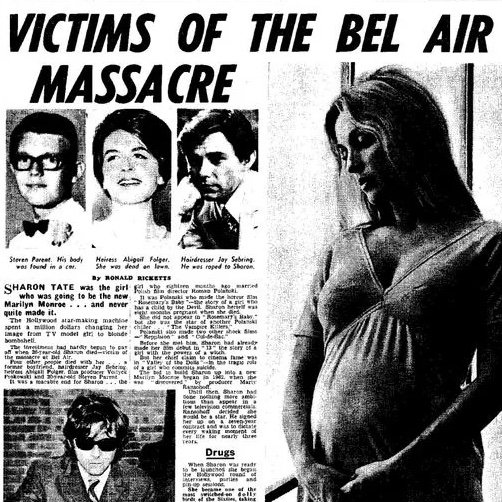Sharon Tate and Roman Polanski
In the summer of 2015, we did 12 episodes on Hollywood before, during and after the Manson family murders of Sharon Tate and at least half a dozen other Angelenos in August 1969. The series focused on Charles Manson as a late-60s version of the classic stereotype of a starstruck pilgrim who is drawn to Southern California out of their belief that they are destined to be famous. Charles Manson’s Hollywood explores what happened when this specific pilgrim turned out to be a career criminal and con artist, and the entertainment industry he crashed was at a crisis point which allowed him to get very close to some very famous and rich people — with obviously tragic consequences.
Episodes:
What We Talk About When We Talk About the Manson Murders, Episode 1: What was going on in the show business capital that made Manson seem like a relatively normal guy? We'll lay out the basic facts of who was killed, and how, in order to begin to explain how these unthinkable crimes fit in to the tapestry of one of the most tumultuous times in Hollywood history. [Listen]
Charlie Manson Finds His Family, Episode 2: Tracing Charles Manson's life from his birth, through multiple stints in reform schools and prisons, and finally to San Francisco circa 1967, where Manson began to try out his guru act on the local hippie kids, and started to form the "family" that he'd eventually migrate with to Los Angeles. [Listen]
The Beach Boys, Dennis Wilson and Manson the songwriter, Episode 3: After bringing his family to Los Angeles so he could look for a record deal, Charlie Manson befriended Beach Boy Dennis Wilson, and used the drummer to gain credibility in the music Los Angeles scene. In this episode we’ll talk about Charlie Manson’s arrival in Los Angeles in 1967 with designs on spreading his gospel through rock n’ roll, and explain how The Beach Boys came to record a song written by Charles Manson. Finally, we’ll talk about how Wilson suffered in the years following his association with Manson, leading up to his own untimely death. [Listen]
The Beatles, The White Album and Spahn Ranch, Episode 4: After wearing out his welcome at Dennis Wilson’s house, Manson moves his family to Spahn Ranch, a dilapidated Western movie set where the cult starts preparing for “Helter Skelter,” Manson's made-up apocalypse inspired by The Beatles. [Listen]
Doris Day and Terry Melcher, Episode 5: Charles Manson became convinced his best chance at rock stardom was impressing Terry Melcher, a record executive who had made stars out of The Byrds, and who was also the son of one of old Hollywood's most wholesome, carefree Establishment stars, Doris Day. Terry and his girlfriend, Candice Bergen, had long lived at 10050 Cielo Drive, and sublet the house to Roman Polanski and Sharon Tate months before the murders. [Listen]
Kenneth Anger and Bobby Beausoleil, Episode 6: The first person to go to jail for a Charles Manson-associated murder was Bobby Beausoleil, a charismatic would-be rock star who had put in time as a muse to Kenneth Anger -- child actor-turned-occultist experimental filmmaker, and author of the first bible of embellished celebrity scandal, Hollywood Babylon. [Listen]
Sharon Tate and Jay Sebring, Epsiode 7: In the first of two episodes about the Manson Family’s most famous victim, we’ll trace actress Sharon Tate’s early years, her romance with celebrity hairdresser Jay Sebring, and the on-set affair that changed the course of Tate’s life and career. Plus: sex, drugs, haunted houses, Warren Beatty and Steve McQueen. [Listen]
Sharon Tate and Roman Polanski, Episode 8: While trying to launch her own acting career, Tate fell in love with, and eventually married, Roman Polanski, the hotshot Polish filmmaker who had his first massive American hit in the summer of 1968, Rosemary’s Baby. Tate and Polanski were often described as Hollywood’s “it” couple during their brief marriage, but behind the scenes their relationship was complicated by his infidelities, and her struggles to prove herself as an actress in films like Valley of the Dolls. [Listen]
August 8-10, 1969, Episode 9: Over the course of a single weekend, half a dozen hippies massacred seven people. This episode includes disturbing details about very violent crimes. [Listen]
Roman Polanski After Sharon Tate, Episode 10: Roman Polanski was in London the night his pregnant wife was murdered in their home. He returned to Los Angeles, devastated, to find himself wanted for questioning in a crime which the LAPD, initially, had no idea how to solve. The next decade of Polanski's life would be a rollercoaster, hitting heights like his masterpiece Chinatown, and lows like his rape of a 13-year-old girl and subsequent exile from the US. [Listen]
Death Valley ‘69, Episode 11: After the murders, Manson moved his family to the depths of the California desert. There, even before they were finally apprehended by the law, their utopia started to fall apart. Hollywood was in the process of being changed by Dennis Hopper's Easy Rider, a film shot partially in the same desert where Manson was now hiding. The Family and their flight to Death Valley -- and the impossible dream of the 60s revolution in general -- was soon thereafter unwittingly reflected in Italian filmmaker Michelangelo Antonioni's attempt to make a Hollywood studio film, Zabriskie Point, starring Hopper's future wife. [Listen]
The Manson Family on Trial, Episode 12: The trials of the Manson family became a kind of public theater which a number of current and future filmmakers found themselves caught up in. Joan Didion bought a dress for a Manson girl to wear to court, Dennis Hopper visited Manson in prison, and a young John Waters attended the trial and took inspiration for his legendary film, Pink Flamingos. [Listen]


